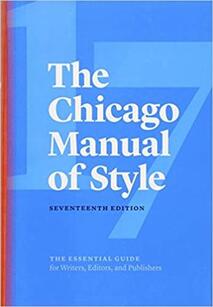
Our entire editorial team had the exact same experience with style guides before entering the publishing industry: we used style guides to format citations for papers in college, and nothing more. If you’re like us, then perhaps you, too, had no idea that a style guide was intended for anything else.
In fact, style guides are massive, complex, and crucially important -- and we barely ever use them for citations anymore (lookin’ at you, nonfiction!). A style guide is a rulebook for writing that outlines grammar prescriptions and recommendations that can also give advice for troubleshooting unusual issues. Listen to our accompanying podcast episode!
Style guides are used to ensure that every publication coming from the same place uses the same grammar system. For example, essentially all fiction books that are published in American English these days are edited using the Chicago Manual of Style (CMS), which the University of Chicago Press has been publishing since 1906. (Students sometimes use Chicago/Turabian, which is a streamlined version of CMS for academics.)
You may recognize some of the hallmarks of CMS, like a preference for the Oxford (or serial) comma. As editors, we rely on CMS to tell us where commas go (spoiler alert: it’s complicated!) and how to format ellipses. . . . It also tells us what order parts of the book go in. For example, CMS prefers that the dedication page of a book goes in the front, while the acknowledgments page should go in the back. CMS also defers all spelling questions to Merriam-Webster’s Dictionary in particular! Some other style guides may be familiar to you, like the Modern Language Association (MLA) style guide or the AP (Associated Press) style guide. Many companies and other organizations also develop their own style guides. These corporate style guides can come in handy when a company like Medium, for example, utilizes hundreds of writers from all around the world but still wants all those articles to be grammatically consistent. That’s the key word here: consistent. The entire purpose of style guides is to ensure that a book’s grammar is consistent throughout; that an author’s books are consistent from one to the next; that a publisher’s book list is edited to a consistent standard; that books across the country are grammatically consistent so readers have an easier time hopping from one to the next. Having a codified system that any editor can turn to, via print style guide or online, is how we achieve this glorious consistency. All this is to say: Your editor is not making up their grammatical recommendations. If you have a really nice editor (say, any editor at Wildling Press), they may take the time to explain some of their corrections to you using CMS as their guide. However, just like any other industry, these rules are complex and layered, stacking on top of each other to create a full spectrum of meaning and clarity. It’s not always easy for an editor to explain why they’ve made a certain correction. But more often than not, there is a grammatical rule (or several!) from CMS behind their correction. Studying the CMS is a great step to take to become a better writer. We once had someone tell us, “I’m not familiar with CMS, but I could read it in a day or two.” Well, they certainly missed the point! Reading the style guide from cover to cover might not do you much good -- unless you have a really excellent memory for that sort of thing. Instead, try evaluating the choices you are making when writing, and then asking yourself, “Why am I making this choice? Is this the right choice?” Before you slap that comma there, try looking it up! Does a comma actually belong there? (As we mentioned, commas are really objectively unreasonably complicated.) Here’s the good news: if working with a style guide is hard for you, you can rely on your editor to show you the way. Just be sure to remember that their corrections come from a good place: the Chicago Manual of Style! by Christina Kann
0 Comments
Leave a Reply. |
How Do I Book?We'll try to find the answer to that question in our blog. Archives
August 2023
Categories
All
|

 RSS Feed
RSS Feed